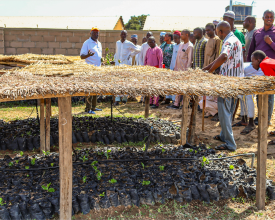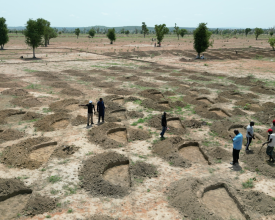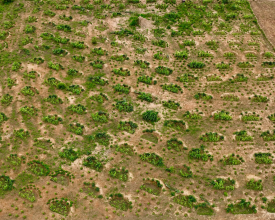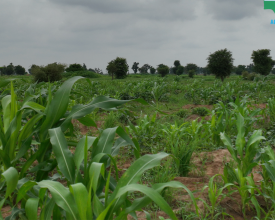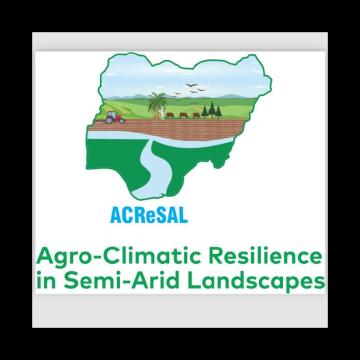
Cultiver le changement : Soutien innovant aux petits agriculteurs de l'État d'Adamawa par le biais de l'agriculture régénératrice
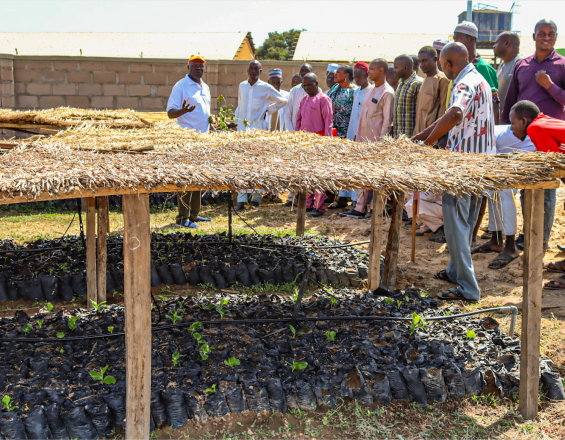
Le projet de résilience agro-climatique dans les paysages semi-arides (ACReSAL) dans l'État d'Adamawa, au Nigéria, vise à lutter contre la dégradation des terres et à renforcer la résilience climatique en promouvant des pratiques d'agriculture régénératrice. Soutenu par la Banque mondiale, ce projet de 6 ans (2022-28) cible les petits exploitants sans terre en persuadant les propriétaires terriens de louer 2 100 hectares de terres sans loyer pendant 10 ans.
L'agriculture régénératrice rétablit la santé des sols grâce à des techniques telles que l'agriculture sans labour, le paillage, les cultures de couverture et la réduction des produits chimiques de synthèse, tout en intégrant le bétail et les abeilles dans le système agricole. Ces pratiques visent à rajeunir les sols dégradés par l'agriculture intensive et à promouvoir une productivité agricole durable.
Cette initiative répond aux défis de la dégradation des sols et de l'insécurité alimentaire en promouvant une agriculture résistante au climat. Le projet ne se contente pas de restaurer les terres, il vise à créer un précédent pour l'adoption d'une agriculture régénératrice dans tout le Nigeria.
Contexte
Défis à relever
- Lavariabilité du climat: Des conditions météorologiques imprévisibles, notamment des sécheresses, des vagues de chaleur et des inondations plus fréquentes et plus intenses, affectent la productivité des cultures et du bétail.
- Dégradation des sols: L'érosion des sols, l'épuisement des nutriments et la désertification réduisent les terres arables et la productivité.
- Accès limité à l'eau: L'accès limité à l'irrigation entrave l'agriculture tout au long de l'année, en particulier pendant la saison sèche.
- Accès limité au financement: Les petits exploitants agricoles ont du mal à obtenir des financements, ce qui limite les investissements dans de meilleures pratiques, équipements et intrants.
- Nuisibles et maladies: La monoculture et le stress hydrique entraînent l'apparition imprévisible de ravageurs et de maladies, ce qui réduit les rendements.
- Diminution du couvert végétal: Les arbres contribuent à la séquestration du carbone, à l'amélioration de la stabilité des sols et de la biodiversité, ce qui stimule la productivité des cultures.
- Diversification limitée: La dépendance à l'égard d'une gamme étroite de cultures ou de bétail réduit la résistance aux risques climatiques et de marché.
- Manque de techniques modernes: Les connaissances limitées en matière d'irrigation efficace, de rotation des cultures et de lutte contre les parasites maintiennent les rendements à un faible niveau.
Emplacement
Traiter
Résumé du processus
La sensibilisation et la participation des communautés sont essentielles à la réussite du projet ACReSAL, car elles garantissent la compréhension et l'appropriation au niveau local de l'intervention menée par l'État et axée sur la restauration des paysages dégradés dans le nord du Nigeria. Cet engagement renforce les capacités des communautés et favorise l'agriculture durable et la gestion des paysages, ce qui est essentiel pour la viabilité à long terme du projet. Le projet encourage également les plans de développement de l'irrigation menés par les agriculteurs, ce qui permet aux agriculteurs sans terre d'adopter des pratiques durables.
Ces éléments sont complétés par un soutien aux moyens de subsistance par le biais de partenariats public-privé, qui réunissent le gouvernement (ACReSAL), le secteur privé et les agriculteurs pour améliorer la productivité agricole. Le renforcement institutionnel améliore encore l'impact du projet en développant les capacités nécessaires pour gérer efficacement les ressources. Cette synergie entre l'agriculture durable, l'implication des communautés, la planification de l'irrigation et la collaboration intersectorielle garantit des résultats positifs dans l'État d'Adamawa, créant ainsi un modèle reproductible pour d'autres régions.
Blocs de construction
Agriculture durable et gestion des paysages
L'intégration de l'agriculture durable et des pratiques de gestion des paysages dans les efforts de restauration des terres est cruciale pour la conservation des sols et de l'eau, la promotion de la biodiversité et l'atténuation du changement climatique. Cette approche permet également d'améliorer les moyens de subsistance, d'accroître les services écosystémiques et de renforcer la résilience. Pour y parvenir, nous avons procédé à des évaluations approfondies, engagé les agriculteurs locaux et d'autres parties prenantes, élaboré des plans adaptés au contexte, dispensé des formations, suivi les progrès accomplis et favorisé le soutien politique. Cela garantit une restauration holistique et durable des terres dégradées, bénéficiant à la fois aux populations et à l'environnement, y compris aux ressources en eau. Il est important que la communauté collabore, contribue et apprenne des approches efficaces de gestion de l'environnement afin de garantir la durabilité à long terme du projet et des pratiques agricoles non durables.
Facteurs favorables
- Donner la priorité à d'autres moyens de subsistance dans le cadre de la restauration des terres.
- Sensibiliser la communauté aux questions environnementales et aux méthodes de prévention de la dégradation des sols.
- Intégrer l'agriculture intelligente face au climat dans la restauration des sols.
- Appropriation par la communauté et soutien du gouvernement.
Leçon apprise
- Souligner l'importance de la participation des communautés pour identifier leurs problèmes prioritaires.
- Sensibiliser la communauté à toutes les interventions, y compris la restauration des ravines et le reboisement, par le biais de campagnes de sensibilisation globales.
- Établir un point d'engagement provisoire, par exemple en collaborant avec les chefs traditionnels, afin d'obtenir le soutien de la communauté.
Renforcement de la communauté
Renforcer la capacité de la communauté à gérer l'environnement, en reconnaissant que plus de 80 % des problèmes environnementaux surviennent dans les zones rurales. Cela souligne l'importance de leur donner les moyens d'améliorer la gestion de l'environnement.
Facteurs favorables
- Garantir la participation et le soutien des communautés à toutes les activités.
- Mettre en place des groupes d'intérêt communautaire (GIC) élus par les communautés pour participer à l'ensemble du processus.
- Engager des ONG focales pour éduquer et sensibiliser les membres de la communauté aux questions environnementales.
Leçon apprise
L'appropriation des projets par la communauté et une compréhension approfondie des objectifs du projet ont été essentielles à la réussite de ce processus de renforcement de la communauté. En favorisant un sentiment d'appropriation, la communauté s'intéresse davantage aux résultats, ce qui se traduit par une plus grande implication et un plus grand engagement. Veiller à ce que les membres de la communauté comprennent pleinement les objectifs et les avantages des projets et contribuent au processus de prise de décision. Cette implication collective permet non seulement d'améliorer l'efficacité des initiatives, mais aussi de renforcer les capacités locales, la résistance au changement climatique et la durabilité à long terme.
Soutien aux moyens de subsistance par le biais d'un partenariat public-privé
Le portefeuille ACReSal vise à sortir 3,4 millions de Nigérians de la pauvreté, en reconnaissant que la dégradation des sols est un facteur clé contribuant à la pauvreté. Un outil crucial pour réaliser une initiative agricole intelligente sur le plan climatique tout en promouvant la durabilité environnementale. La location de terres par les secteurs privé et public permettra aux paysans sans terre de cultiver et d'améliorer leurs moyens de subsistance.
Facteurs favorables
- Soutien du gouvernement et du secteur privé
- Participation des agriculteurs.
- Formation et fourniture de plants.
Leçon apprise
Les partenariats public-privé (PPP) rassemblent l'expertise des secteurs public et privé, permettant à chaque secteur de faire ce qu'il fait le mieux afin de fournir des projets et des services de la manière la plus efficace possible.
Renforcement institutionnel et durabilité
Le projet ACReSAL collabore avec trois ministères clés : Environnement, Agriculture et Ressources en eau. Il opère à plusieurs niveaux institutionnels, notamment au niveau de l'État, au niveau national, au niveau local et au niveau de la communauté. Cette approche garantit le renforcement des capacités des responsables de la mise en œuvre du projet à tous les niveaux ministériels, ce qui permet de soutenir les investissements du projet et d'assurer une gestion efficace des paysages.
Facteurs favorables
- Une collaboration efficace entre les trois ministères et les institutions qui mettent en œuvre le projet par le biais d'engagements réguliers des parties prenantes.
- Grâce à l'appui technique de la Banque mondiale, l'équipe apporte son soutien à l'ensemble des activités du projet et veille à ce que sa mise en œuvre ait un impact.
Leçon apprise
La synergie entre les ministères et les institutions est essentielle pour produire des résultats, car pour que le projet ait un impact, il est essentiel que tous les ministères travaillent en étroite collaboration. La synergie a permis de trouver des idées plus innovantes et plus collaboratives pour une mise en œuvre efficace du projet.
Plans de développement de l'irrigation menés par les agriculteurs
L'objectif est de garantir l'accès et la disponibilité de l'eau pour les agriculteurs et pour l'usage domestique et l'irrigation des éleveurs de la communauté. L'irrigation à la ferme aidera les agriculteurs à mener des activités agricoles tout au long de l'année, ce qui contribuera à augmenter la production alimentaire et à améliorer les moyens de subsistance.
Facteurs favorables
- Renforcement des capacités des agriculteurs pour les aider à élaborer des plans d'irrigation
- Formation de groupes d'intérêt communautaires et sensibilisation
- Fourniture de panneaux solaires, forage de puits et de réservoirs d'eau pour mieux stocker l'eau.
Leçon apprise
- En raison des problèmes liés à la concurrence entre les agriculteurs et les éleveurs pour les ressources naturelles en déclin. L'irrigation conduite par les agriculteurs peut leur permettre de rester sur leur site et leurs terres et de réduire les déplacements des éleveurs, ce qui réduit la probabilité de conflits liés aux ressources naturelles et peut servir de mécanisme pour améliorer les possibilités de consolidation de la paix entre les agriculteurs et les éleveurs.
- Amélioration du niveau de vie et de la santé de la communauté grâce à l'amélioration de l'accès à l'eau potable.
Impacts
Cette initiative innovante lève les obstacles financiers, permettant aux agriculteurs sans terre de pratiquer une agroforesterie résiliente au climat et d'obtenir des récoltes durables. En juin 2024, plus de 20 000 agriculteurs auront été formés à l'agriculture régénératrice grâce à des centres de formation et de démonstration mis en place à Yola North, Girei et Yola South LGA dans l'État d'Adamawa. Les récoltes des parcelles de démonstration - maïs, pastèques, légumes, pois d'Angole et niébé - ont été données aux agriculteurs qui les ont cultivées, fournissant ainsi des aliments pour la consommation domestique ou des revenus supplémentaires provenant de la vente.
En outre, le projet ACReSAL de l'État d'Adamawa a obtenu des baux gratuits de 10 ans pour 375 hectares de terres dans cinq LGA, et 582 agriculteurs exploitent maintenant 256 hectares de ces terres. Ces parcelles sont louées à raison d'un acre (0,4 hectare) par agriculteur, ce qui permet aux paysans sans terre de cultiver et de conserver leurs moyens de subsistance.
Ce système de production alimentaire axé sur les résultats permet non seulement de restaurer la santé des sols, mais aussi de soutenir l'agriculture durable grâce à des partenariats solides entre le gouvernement, le secteur privé et les agriculteurs locaux. Le succès de cette approche dans l'Adamawa sert de modèle pour la mise à l'échelle de projets similaires dans d'autres régions, offrant des solutions à long terme pour la résilience climatique et la sécurité alimentaire.
Bénéficiaires
20 000 agriculteurs et agricultrices sont les bénéficiaires directs de ce projet.
Objectifs de développement durable
Histoire
Denis Damara, de l'AGL de Girei, est convaincu de cette approche : "Je suis un agriculteur chevronné, mais j'ai appris beaucoup de choses nouvelles ici. J'ai notamment appris que nous devrions éviter de brûler nos fermes. J'ai appris que nous devrions conserver les herbes et les tiges après la récolte pour qu'elles puissent servir de paillis au sol et conserver l'humidité dans le sol. J'ai également appris à élaguer les arbres et à construire des structures en demi-lune pour conserver l'eau pour les arbres et les cultures vivrières autour de l'arbre. J'ai essayé cela chez moi et ça marche".
